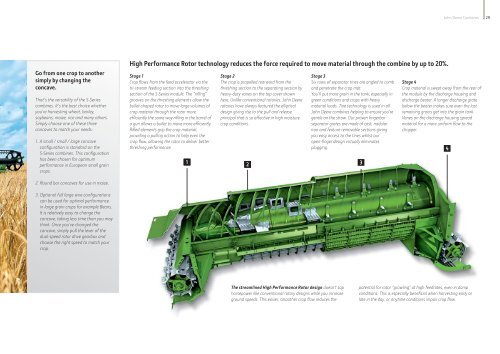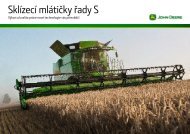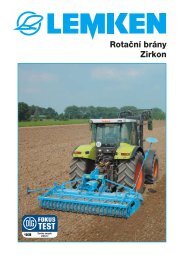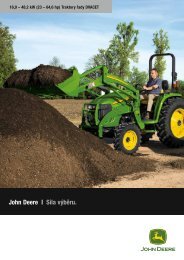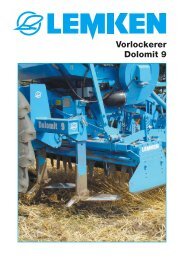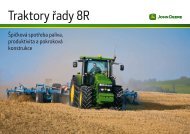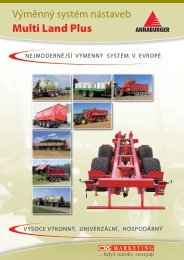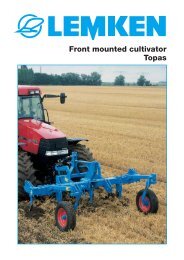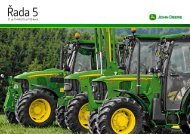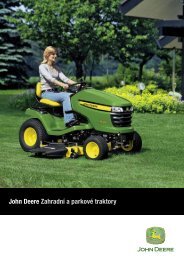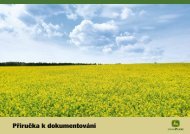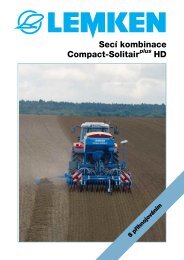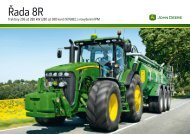John Deere Combines
John Deere Combines
John Deere Combines
Create successful ePaper yourself
Turn your PDF publications into a flip-book with our unique Google optimized e-Paper software.
<strong>John</strong> <strong>Deere</strong> <strong>Combines</strong> 29<br />
Go from one crop to another<br />
simply by changing the<br />
concave.<br />
That’s the versatility of the S-Series<br />
combines. It’s the best choice whether<br />
you’re harvesting wheat, barley,<br />
soybeans, maize, rice and many others.<br />
Simply choose one of these three<br />
concaves to match your needs:<br />
1. A small / small / large concave<br />
confi guration is standard on the<br />
S-Series combines. This confi guration<br />
has been chosen for optimum<br />
performance in European small grain<br />
crops.<br />
High Performance Rotor technology reduces the force required to move material through the combine by up to 20%.<br />
Stage 1<br />
Crop fl ows from the feed accelerator via the<br />
tri-stream feeding section into the threshing<br />
section of the S-Series module. The “rifl ing”<br />
grooves on the threshing elements allow the<br />
bullet-shaped rotor to move large volumes of<br />
crop material through the rotor more<br />
effi ciently the same way rifl ing in the barrel of<br />
a gun allows a bullet to move more effi ciently.<br />
Rifl ed elements grip the crop material,<br />
providing a pulling action to help even the<br />
crop fl ow, allowing the rotor to deliver better<br />
threshing performance.<br />
1<br />
Stage 2<br />
The crop is propelled rearward from the<br />
threshing section to the separating section by<br />
heavy-duty vanes on the top cover shown<br />
here. Unlike conventional rotaries, <strong>John</strong> <strong>Deere</strong><br />
rotaries have always featured the elliptical<br />
design giving rise to the pull and release<br />
principal that is so effective in high moisture<br />
crop conditions.<br />
2<br />
Stage 3<br />
Six rows of separator tines are angled to comb<br />
and penetrate the crop mat.<br />
You’ll put more grain in the tank, especially in<br />
green conditions and crops with heavy<br />
material loads. Tine technology is used in all<br />
<strong>John</strong> <strong>Deere</strong> combines helping to ensure you’re<br />
gentle on the straw. Our proven fi ngerbar<br />
separator grates are made of cast, nodular<br />
iron and feature removable sections giving<br />
you easy access to the tines whilst our<br />
open-fi nger design virtually eliminates<br />
plugging.<br />
3<br />
Stage 4<br />
Crop material is swept away from the rear of<br />
the module by the discharge housing and<br />
discharge beater. A longer discharge grate<br />
below the beater makes sure even the last<br />
remaining grains get into the grain tank.<br />
Vanes on the discharge housing spread<br />
material for a more uniform fl ow to the<br />
chopper.<br />
4<br />
2. Round bar concaves for use in maize.<br />
3. Optional full large wire confi gurations<br />
can be used for optimal performance<br />
in large grain crops for example Beans.<br />
It is relatively easy to change the<br />
concave, taking less time than you may<br />
think. Once you’ve changed the<br />
concave, simply pull the lever of the<br />
dual-speed rotor drive gearbox and<br />
choose the right speed to match your<br />
crop.<br />
The streamlined High Performance Rotor design doesn’t sap<br />
horsepower like conventional rotary designs while you increase<br />
ground speeds. This easier, smoother crop fl ow reduces the<br />
potential for rotor “growling” at high feedrates, even in damp<br />
conditions. This is especially benefi cial when harvesting early or<br />
late in the day, or anytime conditions impair crop fl ow.


